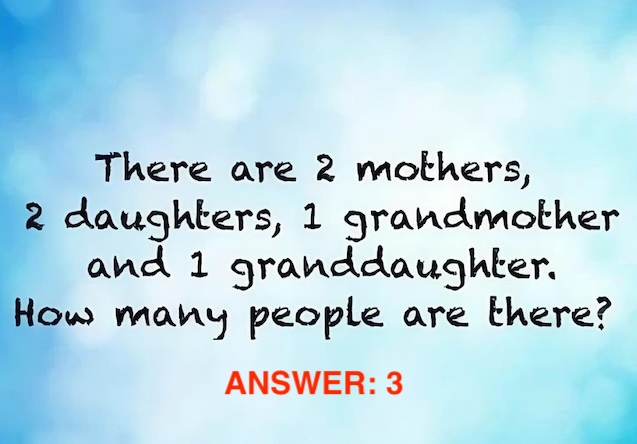At first glance, this riddle seems almost too easy. Two mothers, two daughters, one grandmother, one granddaughter… So you’d think six people, right? Hold that thought. This little brain teaser has been tripping people up for years—and not because it’s complicated. Nope, it’s because our brains love to assume instead of analyze.
So let’s break it down and figure out what’s really going on in this deceptively simple family puzzle.

The Puzzle Everyone Gets Wrong at First
Here’s the riddle: There are two mothers, two daughters, one grandmother, and one granddaughter. How many people are there?
Your first instinct is probably to start counting: two moms + two daughters = four people. Add a grandmother and a granddaughter, and you’ve got six, right? Wrong. This is where the trap springs.
This isn’t a math problem—it’s a logic challenge. And logic loves to play dress-up with roles and relationships.
Why This Puzzle Feels Tricky
The catch? We tend to count each title as belonging to a different person. But in families, one person can wear multiple hats. Your mom is also your grandma’s daughter. You’re someone’s kid and maybe someone else’s parent.
That’s the core trick: relationships can overlap. And when you fail to see that, the numbers stop adding up.
Video: 21 Riddles That Will Turn Your Brain Upside Down
The Common Pitfall: Counting Roles, Not People
Let’s look at the breakdown people think they’re seeing:
- Mother #1
- Mother #2
- Daughter #1
- Daughter #2
- One grandmother
- One granddaughter
Boom. Six roles. So our brains go, “Okay, six people.” But here’s the thing—roles aren’t the same as individuals.
Imagine walking into a party and someone introduces themselves as a mom, a daughter, and a sister. That’s still just one person, not three. See where we’re headed?
Let’s Solve This Puzzle Step by Step
Let’s untangle the relationships carefully—because this isn’t a family reunion with six chairs around the table.
- Person 1: The Grandmother
She’s obviously a mother (to her daughter) and a grandmother (to her granddaughter). She’s already covering two roles. - Person 2: The Mother
She’s the daughter of the grandmother, making her both a daughter and a mother. She’s the mom of the granddaughter and the daughter of the grandmother. - Person 3: The Granddaughter
She’s simply the daughter of the mother, and the granddaughter of the grandmother.

So how many actual people are we talking about? Three. Just three.
Roles? Six.
Humans? Three.
Mind blown? Probably.
How It All Adds Up
Let’s recheck:
- Two mothers: The grandmother and the mother
- Two daughters: The mother and the granddaughter
- One grandmother: The oldest woman
- One granddaughter: The youngest girl
That’s all of them. Every title checked off the list. No extra people hiding in the bushes.
Why Puzzles Like This Matter
It’s not just a cute riddle to pass time—it actually teaches you a valuable skill: flexible thinking. So much of what we do every day depends on assumptions. And while assumptions save us time (we don’t want to analyze every single thing in life), they also lead to silly mistakes.
This riddle trains you to stop, think, and rethink. It challenges you to look past the obvious. That’s powerful.
Ever wonder why brain teasers like these pop up in job interviews and cognitive tests? Because they reveal how you approach problems. Are you the kind of person who jumps to conclusions—or digs a little deeper?
Still Stumped? Don’t Sweat It
Video: Let these fun quiz videos bring excitement to your day!
If this riddle fooled you the first time, you’re in great company. Most people miss it at first. That’s why it’s so satisfying when you finally get it. There’s this tiny light bulb moment that makes you go, “Ohhh, of course!”
That rush? That’s your brain doing a victory lap. That’s growth.
Conclusion: One Puzzle, Three People, Countless Lessons
What looks like a straightforward riddle turns into a powerful reminder: things aren’t always what they seem. This classic puzzle proves how easy it is to confuse roles with people, and why paying attention to structure and relationships matters more than quick math.
So the next time you see a problem that seems simple, take a step back. Ask questions. Think sideways. And maybe—just maybe—you’ll spot the trick everyone else missed.
And now that you know the answer, don’t keep it to yourself. Try it on a friend. Watch them furrow their brow, start counting, then pause. Trust me, watching the realization hit is half the fun.


